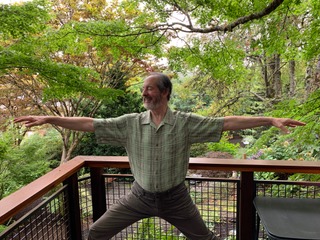“Reality is a cliché from which we escape by metaphor,” observed the poet Wallace Stevens.
While for a mindful practitioner, yoga never descends to the level of a cliché. Standard yoga poses, done in standard ways, can over time seem routine and stale.
Metaphors, when we inhabit them in our bodies and breath, can give new meaning to old poses. They can even add a bit of mysterious delight, a kind of enchantment, to a longtime practice.
I’d like to share three metaphors that have enchanted me.
The Armpit as a Bridge
In a recent Zoom-based class in the yoga sanctuary I’m a member of, my teacher, Leslie Ellis, invoked a metaphor that one of her teachers had shared with her: “Let the armpit be the bridge between the hand and the heart.”
I smiled with aesthetic pleasure at this image. There was something elegantly original about language that transformed a plain armpit into a beautiful hub of connection.
But it wasn’t just the language that struck me. It was the metaphor’s somatic impact.
As I imagined my armpit as a heart-to-hand bridge, I noticed resistance in my armpit area when I did Warrior II. (In this pose, for those unfamiliar with it, you spread your feet out wide, turn one foot toward the short end of your mat, and bend your knee on that side. You then lengthen your arms out so they’re parallel with the floor, as in the photo above, and turn your head to look over the fingers of the hand on the bent-leg side.)
This resistance I encountered in Warrior II was hardly delightful, as the inspired originality of the bridge metaphor appeared. But it was instructive. My outstretched hand on my bent-leg side was pulling my armpit outwardly with it, away from my heart. It was as if my armpit was the near side of a bridge that was being yanked toward the far side. In reaching out with my arm to grab hold of life’s possibilities, I was losing the grounding of my centered heart.
So, I decided to treat Warrior II as a site for heart-to-hand bridge building. I saw in my mind’s eye the bridge of energy between my heart and hand with the armpit as its hub. I softened my gaze over the fingers of my extending hand and then softened my elbow to create more space for my energy to flow. I let my arm simultaneously reach away from my body and back in again as if I were walking across the bridge in both directions. I encouraged my breath to fill my armpit’s rounding openness. The enchantment of the bridge imagery was finding expression in the easeful balance I felt in the pose.
The Hip Joint as an Egg in the Nest
The hip joint may lack the negative connotations of an armpit. But it doesn’t seem to have notably positive connotations either. The joint feels to me like an ordinary part of the ordinary machinery of the body.
But when I regard this joint as a piece of machinery, it’s prone to break down. On my left-leg side, in poses that ask me to flex my hip and raise my leg off the ground, like Tree Pose, the head of my thigh bone sometimes seems to poke up and forward in the hip socket and press against its rim. This can cause pain.
When I was experiencing this sort of hip pain a few months ago, one thing that helped (along with physical therapy and a private yoga lesson) was to imagine my hip joint on my left side as an egg in the nest. (I did have X-rays to rule out arthritis as a source of pain.)
What came to me was that the ball of my hip joint was like an egg, and the socket of the joint was like a nest. I wanted the egg to be cradled by the nest and receive its nourishment. If the egg was pushed out of the nest or was jammed against its edges, the egg would not be nourished and might even crack.
The image of a cozily held egg in the nest seemed to bring comfort and pleasure when doing poses like Tree that required me to flex my left hip and float my foot off the ground. I imagined my hands cupping my at-risk egg and settling it back into its nested home. And then, when standing on my right leg, I imagined a little bluebird hatching from the nested egg and escorting my bent leg upward toward my opposite thigh. I felt a sense of freedom in my hip and a playfulness in the flight of my leg.
It seemed as if my hip joint metaphor was teaching my mind how to think about the ball and socket joint in a more natural and beneficial way. This teaching process was mysterious to me, but it was a pleasing mystery that I was happy to just let be.
Mindfulness as the Gentle Rain of Awareness
In my early years of yoga, I came upon Jon Kabat-Zinn’s definition of mindfulness as “awareness that arises through paying attention, on purpose, in the present moment, non-judgmentally.”
I knew that yoga, as an ancient wisdom tradition, had mindfulness at its core.
Without the cultivation of mindfulness, yoga was mere exercise.
However much I respected and valued the concept of mindfulness, I found it a bit hard to relate to while I was doing yoga poses. The concept seemed abstract and difficult to visualize or touch into.
But my ears perked up in class one morning when I heard the teacher refer to mindfulness as “the gentle rain of awareness.” (I believe she said that this metaphor was from an ancient Buddhist teaching.)
My ears perked up because gentle rain was something I could feel a part of. I could see the rain in my imagination and feel drops of water drizzling down over my eyelids and sliding onto my cheeks. I could sense warm pulses of water tapping on the tip of my nose. My mouth opened and my tongue curled up to taste this gift from the heavens. The gentle rain was enchanting.
And I certainly was not inclined to judge the gentle rain. That wouldn’t have made sense. I sensed and savored the raindrops; no evaluation was called for.
To be sure, I understood that mindfulness did not mean that you were open only to pleasing sensations. In a pose, mindfulness might mean that you felt harmony and grace for a while but discordance and awkwardness a few moments later, or maybe you felt contradictory feelings at the same time. But the idea was to listen openly and generously to what your body was telling you without getting locked into a judgment about the goodness or badness of the body’s signals.
And in yoga poses, mindfulness also suggested that you let the body’s messages lead the way to adjustments that might bring more benefits. Just as you might put a hat over your head if gentle rain started to come down harder, so, too, might you reach for a yoga block or blanket to ease your efforts. As Kabat-Zinn has said, mindfulness is in the service of self-understanding and wisdom. And wisdom involves a deep knowing from within about what would be of benefit.
Metaphors can stir rich associations and deep possibilities of meaning. When this stirring happens in yoga, delightful discoveries can arise, even after many years of practice.












Read 13 comments and reply